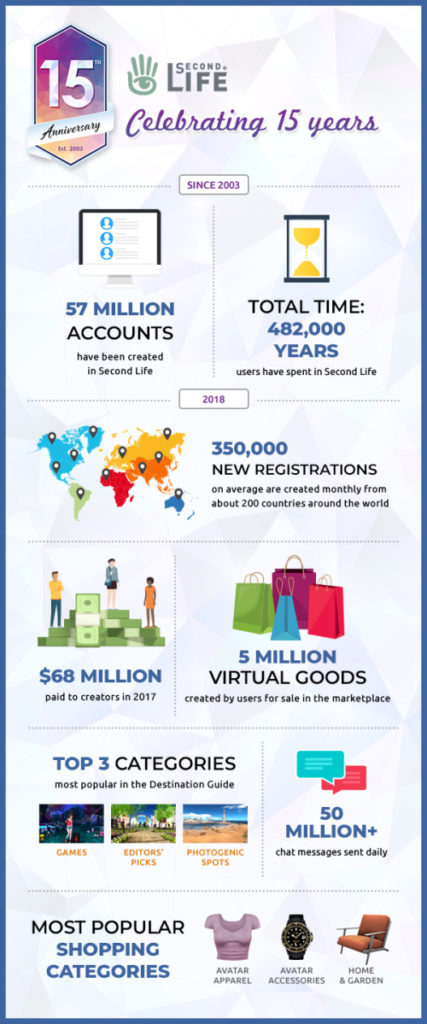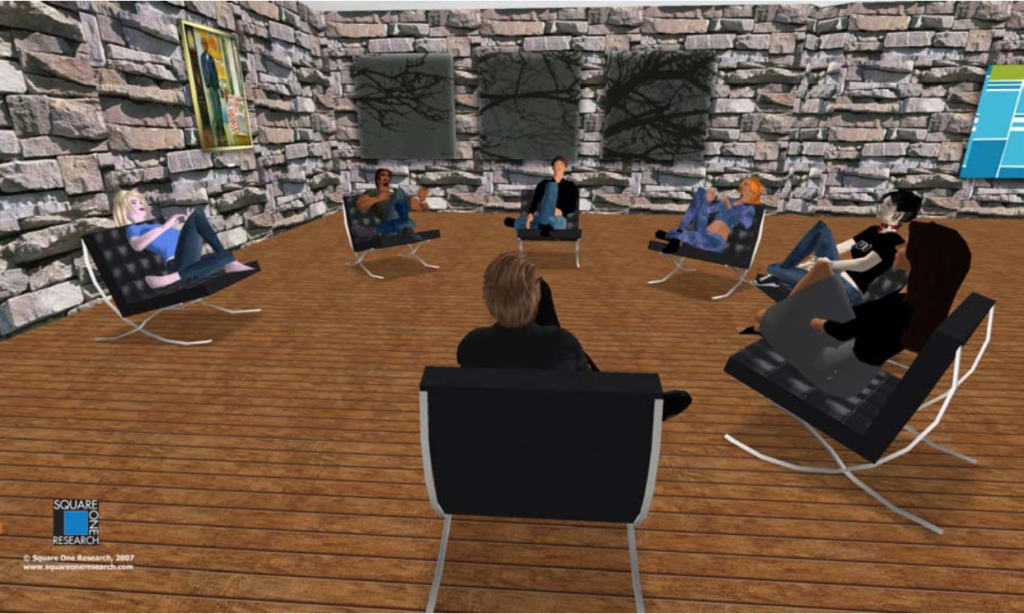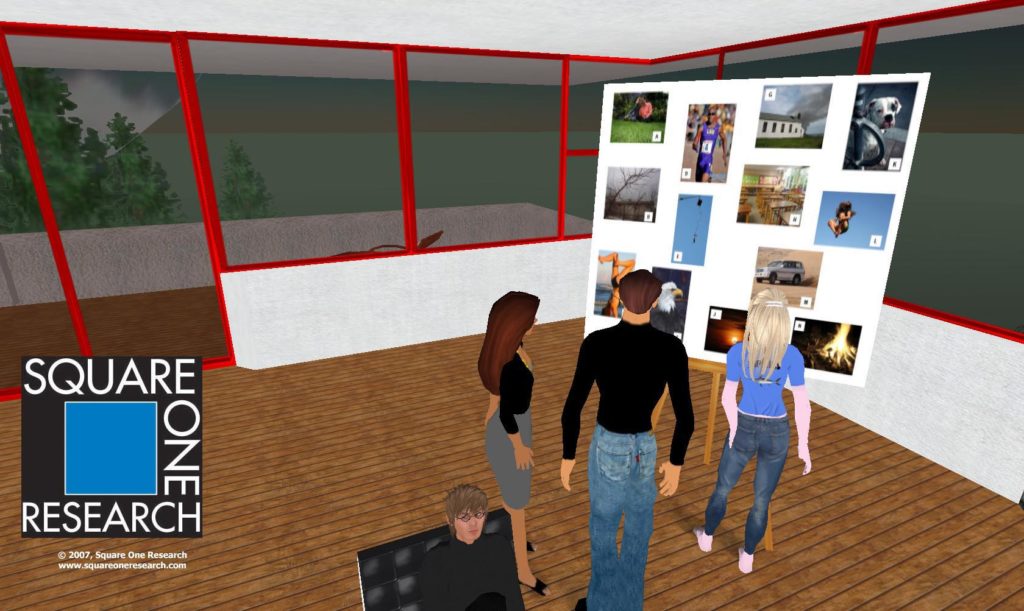From the fall of 2006 to early 2008, I was obsessed with Second Life, a virtual world where users could create and customize an avatar, purchase virtual land plots with real money, and build virtual structures bound only by the limits of their imaginations. While the equally obsessed business media saw it as the epitome of Web 2.0 technology, I saw it as a potentially game-changing market research platform that would give new meaning to online qualitative especially.
Companies were developing “virtual world strategies” in a manner reminiscent of the euphoria surrounding the web in 1997 and TikTok’s momentum right now. The May 1, 2007, Business Week cover story chronicled Anshe Chung, an avatar who had amassed virtual land holdings worth more than $250,000. The magazine even ventured that Second Life could mount a challenge to Microsoft’s dominant Windows operating system.
And then, in a flash, it seemed that Second Life vanished from the headlines. What happened? Why did an application, where the likes of Starwood, Reuters, and Cisco had a presence, become back page news? And where is it now?
 First, What Is Second Life?
First, What Is Second Life?
In case your memory of Second Life is hazy or you have never even heard of it, it is important to understand what it is and what it’s not.
- Although Second Life is a virtual world, it is not a virtual reality platform. Rather, it is an alternate reality platform accessed via a computer.
- Second Life is not a game. There are no winners or losers. There is no goal other than to experience the virtual world itself.
- Users create an account on SecondLife.com, download an application to their computers (Second Life does not run on tablets or phones), and then login. Everyone begins as a stock avatar but is free to customize their appearance.
- An avatar can be a virtual resemblance of one’s real-life physique or something totally different. Users can decide their first names but pick from a long list of last names. In 2007, I became Jonathan Sellers and no matter how much I tried to look like me, I always bore a striking resemblance to Harry Potter.
- To travel in the virtual world, one teleports to various destinations on a virtual “grid” (the technical term for the server-driven digital rendering of the world). Finding places to go involves searching key words, events, and topics similar to navigating the web.
- Spending time in Second Life is free, and there are lots of free virtual items to find. However, unless one is particularly talented at using the world’s building/scripting engines, money is necessary to buy fancy clothes for your avatar, buy virtual land, and buy virtual furniture and art to furnish your virtual home. One can upgrade to a premium account (ninety-nine U.S. dollars per year) which gives one a “ready-to-move-in” virtual home, the opportunity to visit exclusive areas of the grid, and enhanced technical support, among other benefits.
- Avatars hawk their wares and services which range from the expected (house builder, landscaper, fashion designer) to the bizarre (surrogate mom for a virtual baby). In 2007, stories exploded about people who had side businesses in Second Life that earned them well into the five and six figures.
- Fortunately, Second Life has its own currency, Linden Dollars, which trades on an open exchange. Throughout 2006 and 2007, one U.S. dollar bought roughly one Linden dollar. As of April 6, 2020, one U.S. dollar equaled $320 Linden. Linden dollars would not have been a good investment… Is $320 Linden a lot or a little? It depends—prices for digital assets and services vary widely on the Second Life marketplace. For reference, a customizable avatar shape can go for ten Linden dollars. A full ensemble of men’s clothes can fetch $2,500 Linden.
- Second Life exists because Linden Lab, a private company, runs it. Linden Lab makes its money via premium memberships, virtual land use fees (i.e., taxes) from those who own virtual property, and transaction fees on all other purchases.
The Numbers—Then and Now
As Linden Lab is a private company, user statistics are difficult to obtain. The company seems to waver between reporting registrations, total users created, residents, and monthly active users (MAU, which is the average number of users who logged in during each month of a quarter). (http://wiki.secondlife.com/wiki/Linden_Lab_Official:Linden_Lab_economic_metric_definitions).
Official numbers paint a portrait of growth but may not recognize the large number of users who download the application, login once, and then never come back.
- On October 18, 2006, Second Life surpassed one million residents. (http://wiki.secondlife.com/wiki/History_of_Second_Life)
- In 2013, the company also reported approximately one million MAUs and thirty-six million accounts created since the platform’s inception. (https://community.secondlife.com/blogs/entry/947-sl10b-infographic-ten-years-of-second-life/).
- In 2018, according to a fifteen-year anniversary infographic (https://nwn.blogs.com/nwn/2018/04/second-life-15th-anniversary-infographic.html), fifty-seven million accounts had been created in Second Life with an average of 350,000 new registrations each month.
In a recent interview with VICE News, Ebbe Altberg, the current CEO of Linden Lab, stated that Second Life has about 900,000 active users. He also noted that the COVID-19 pandemic has resulted in an uptick of users. “While businesses have consistently used Second Life for remote meetings and training for many years, we are seeing a significant increase in demand now as organizations seek out online solutions that offer something more engaging than video conference calls,” Altberg told VICE.
Regardless of the numbers, it is safe to assume that usership and overall interest declined after 2007 simply due to the rise of Facebook, Twitter, YouTube, and other social networks. Undoubtedly, the COVID-19 pandemic has benefited Second Life as locked-down people have sought out new (and old) ways to connect with one another. Yet, Second Life remains a niche interest at best.

Second Life allows researchers the opportunity to interact with respondents in a virtual space that can be designed as a living room or a store environment.

Understanding the Appeal in 2007
In true qualitative research fashion, when I first joined Second Life, I was obsessed with understanding the appeal. To that end, we built a virtual office and hastily recruited a random group of users for a virtual focus group to simply learn how users got interested in Second Life and what kept them coming back for more.
Users spoke of Second Life as what they originally envisioned the internet was supposed to be—more personal than a chat room with the ability to have genuine real-time interactions with people from around the globe. Second Life also gave them freedom to do things they might not be able to do in the real world, whether that was visiting a virtual destination or being a different version of themselves.
Sex can often be the first activity to exploit any new technology and Second Life was no exception. As one user put it, “The mind is the biggest and best sex organ. You can interact here with complete strangers, have a mind-blowing experience, and not have to face them over breakfast the next morning.”
People could also flex their entrepreneurial muscles on Second Life much more easily than in the real world. It was an incredible creative outlet for design, music, and even virtual hairstyling. One of the group’s participants mentioned, “I like the fact that the money here has actual value, and you really can set up a business just trading virtual stuff and ideas. That’s incredible.”
In the spring of 2007, we built a larger office on our own private island. To do that, we hired a landscaper, an architect, and a general contractor—all virtually! The result was perhaps the most stunning qualitative venue ever. I recall simply gazing into the monitor wishing that real facilities could be similar. We also ratcheted up recruitment efforts to create a panel of 3,000 users.
Yet, after conducting some groups for our own purposes and a few for some of our most forward-thinking clients, we ultimately abandoned our virtual island and panel. Second Life seemed to be stagnant. It was hard to find new panelists, and businesses that dipped toes in the virtual water quickly seemed to pull them out of it. Not to mention, Facebook would soon become the rage. It was difficult to convince anyone of the potential of a virtual world when an online real one was giving them so much more.
The Second Time Around
The sudden onslaught of the COVID-19 pandemic and the total shutdown of in-person research forced me to look for ways to make online qualitative more immersive. It reminded me of what I had hoped to accomplish with Second Life originally and nudged me to take a second look at it.
I had long ago lost the username and password for my Jonathan Sellers account, so I had to create a new avatar. After downloading the application and logging in, I chose a stock male avatar and plunged into the default setting for newbies.
What struck me first was not the world around me on screen but rather my computer’s fan. Back in 2006, I remember Second Life taxed my PC’s resources. I am a Mac user now and all computers’ graphics capabilities are far more advanced than back then, but Second Life seems to be just as resource intensive.
My avatar’s default “look” (‘70s style print shirt, bell bottom jeans, and no shoes) needed to change, but I found the process of editing my appearance no easier than before. After a few attempts to get my hair and face to resemble my real-life guise, I gave up and simply changed into a more fashionable suit. I managed to make it to a men’s clothing emporium where I was able to purchase an ensemble that felt more like something I would wear in the real world. Try as I might though, I was unable to find a pair of orange glasses. I would have likely hired a virtual optician to make a pair, but could not connect with one. I assumed virtual sex would still be a big draw and some conversations with various avatars confirmed my assumption. I journeyed around Second Life in May, right before the end of mass social distancing. As one avatar put it, “I can’t go anywhere but here. My sex life is now virtual like it or not.”
The Potential for Virtual Worlds
My recent experiences with Second Life have not rekindled an interest to spend more time there. However, it’s been interesting and given me perspective on Second Life’s meteoric rise into oblivion and why it might still have trouble growing.
- Using the virtual world to its fullest requires a powerful computer with a dedicated graphics card. Second Life became popular right around the time that laptops supplanted desktops. At that time, laptops usually had integrated graphics cards. While Second Life can run on such machines, graphics render much slower and the experience is subpar. Even using a powerful machine today, Second Life can still be laggy and slow to render images.
- The learning curve was and still is steep—very steep. Even the most technologically sophisticated person needs time to understand how to use and master the building tools and virtual world protocols. In 2007, the grid had difficulty accommodating the rapid population growth of late 2007 and 2008. The grid was often down, users could not login, or the in-world experience was painfully slow. With the world at your fingertips, it can be difficult to decide where to go and what to do. It takes time to understand how to sit down, how to raise a hand, or even how to simply begin a conversation with someone.
- Perhaps most telling, many venues lacked critical mass of attendance due to the nature of virtual worlds themselves. For example, Starwood built an amazing virtual rendition of its then-concept, an Aloft Hotel property. However, whenever one went there, it was empty. Social networking relies upon a critical mass of people to post, view, and participate. However, sites like Facebook do not need to have everyone participate simultaneously—as long as users see a steady stream of activity over the course of time, their interest level is steady. With Second Life however, seeing the activity as it happens is critical. A party is not much fun if most of the guests are not there at the same time.
- For businesses, creating a virtual space still means needing to staff it and getting people to come through the door. The infrastructure is not there to support sophisticated advertising and communications. Efforts to attract twenty people to a virtual store or concert may not be worth it.
Yet, I remain bullish on virtual worlds, at least for research purposes and especially now in the context of COVID-19. Imagine if one of our clients created a virtual store environment that we could take people through where they could purchase digital items. What if users could build exact scale replicas of their homes and then invite us in for a virtual in-home interview? There is likely to be a melding of virtual worlds and augmented and virtual reality technology. Prices for virtual reality headsets are declining, and the technology is only getting better.
There were other virtual worlds before Second Life and there still are (i.e., Minecraft, The Sims, Sansar, World of Warcraft). It’s not always possible for us to imagine what comes next. Yet, we do know there is an inexorable progress of technology. For now, however, perhaps there is an opportunity for a virtual world that is more like real life.


5 Trackbacks / Pingbacks